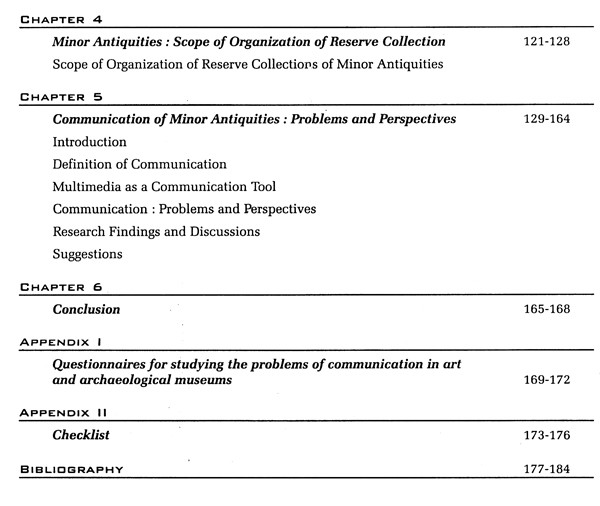
Minor Antiquities in the Museums of Eastern India (An Old and Rare Book)
Book Specification
| Item Code: | UAW409 |
| Author: | Mahua Chakrabarti |
| Publisher: | R.N. Bhattacharya, Delhi |
| Language: | English |
| Edition: | 2007 |
| ISBN: | 8187661836 |
| Pages: | 192 (Throughout B/w Illustrations) |
| Cover: | HARDCOVER |
| Other Details | 11.00 X 9.00 inch |
| Weight | 630 gm |
Book Description
Distributed in seven chapters, this book describes different types of minor antiquities, the history of collection in different museums in Eastern India. A museological study has been dono regarding the documentation of minor antiquities, their storage control, exhibition and communication of the inherent meaning of those tiny objects. It also put some suggestions for betterment of the exhibition and communication in museums.
Mahua has written a number of articles in different museological journals. She also manages a Web Page on Museology www.geocities.com/hubherit age. She is also the co author of the book "Museums: Norms and Terms: A Selective Approach" (Sankha Basu & Mahua Chakrabarti, 1999, Kolkata: Dey's Publishing). Another book is in press to be published soon from the National Book Trust.
I express my deep regards to Prof. Samir Kumar Mukherjee, former Professor and at present Emeritus Fellow, Department of Museology, who as my supervisor of the Ph.D. programme helped me masterminding the treatise. I obtained active support from Dr. Chhanda Das, Reader & Head of the Department of Museology, Calcutta University, Dr. Sakti Kali Basu, former Director, Indian Museum, Kolkata, Dr. Gautam Sengupta, Director, Directorate of Archaeology and Museums, Government of West Bengal.
I appreciate and acknowledge all the help and suggestions from Smt. Gagari Chakrabarti, Lecturer in Economics, Barasat Government College, Sri Debasis Bandyopadhyay and Smt. Manas! Bandyopadhyay. Smt. Reshmi Chattopadhyay, Smt. Kausiki Bagchi and Sri Sankha Basu, Museum & Art Gallery, Ramakrishna Mission Institute of Culture, Golpark.
Originating from the Mouselon. the museum subsequently attained its modern form through a long process. Man's Inherent nature in accumulating and preserving treasures for personal and family security and self glorification gradually transformed into the collections for public use, education and pleasure. Museum, a 'cultural memory bank of the age now matured in an important institution signifying history of civilization and pointing to future progress.
However, it is arbitrary to think that museums are simply for collecting and preserving objects of curiosity. Now, museums are not secluded from society. They develop along with other social institutions, practices, values and attitudes. Albelt the nucleus of a museum is tactile objects, the essential value of collections is judged by the message within them and how effectively the message is communicated to the global community.
**Contents and Sample Pages**














